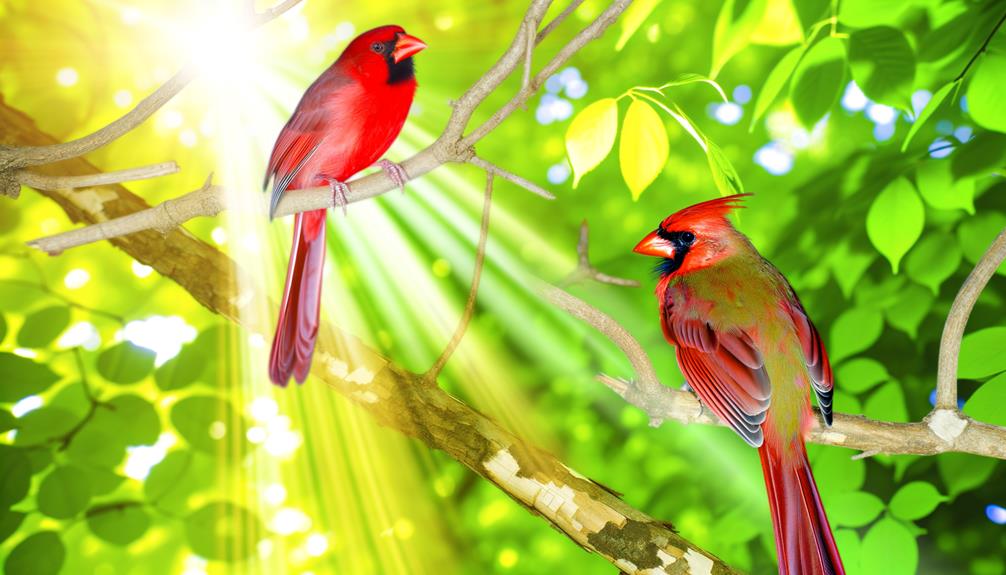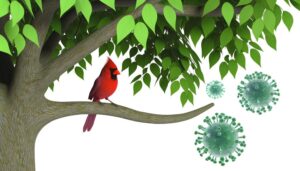Analyzing Cardinal Feather Color: A Case Study Step-by-Step
Cardinal feather coloration results from intricate genetic, dietary, and environmental interactions. Key alleles, such as CYP2J19, dictate pigment conversion, while carotenoid-rich diets enhance color intensity and visual appeal.
Environmental variables, including habitat and sunlight, further influence pigmentation. Seasonal changes, primarily through molting and hormonal fluctuations, also play essential roles.
During the breeding period, brighter plumage in males, amplified by testosterone and dietary shifts, signals health and genetic quality to potential mates. These factors collectively shape the vivid red hues characteristic of cardinals, providing deeper insights into avian ecology and evolutionary biology.
Explore further to understand the complexities involved.

Key Takeaways
- Genetic polymorphisms, particularly at the CYP2J19 gene, determine cardinal feather color morphs.
- Carotenoid-rich diets, including fruits, seeds, and insects, intensify cardinal feather coloration.
- Environmental factors like habitat type and sunlight exposure influence feather color variations in cardinals.
- Seasonal changes, including molting and hormonal shifts, impact cardinal feather pigmentation.
- Bright feather coloration in male cardinals signals health and genetic quality, crucial for mating success.
Genetic Factors
Understanding the genetic factors influencing feather color in cardinals necessitates a deep exploration of allelic variation and gene expression pathways. Cardinals exhibit red, yellow, or even rare color morphs due to specific alleles at loci such as the CYP2J19 gene, which plays a pivotal role in carotenoid deposition.
Genetic polymorphisms within these loci dictate the pigmentation process by modulating enzyme activity that converts dietary precursors into pigments. Moreover, gene expression pathways involving transcription factors and regulatory proteins govern the spatial and temporal distribution of these pigments in feathers.
The interplay between genotype and phenotype is complex, with epigenetic factors also contributing to the manifestation of feather color. Detailed genetic analyses reveal the intricate mechanisms underlying this phenotypic diversity, underscoring the importance of molecular genetics in avian biology.
Diet and Nutrition
Dietary intake plays an important role in the pigmentation of cardinal feathers, as the availability of carotenoid-rich foods directly influences color intensity and hue.
Carotenoids, the primary pigments responsible for red, orange, and yellow coloration, must be ingested through dietary sources such as fruits, seeds, and insects. Studies indicate that cardinals consuming higher concentrations of carotenoid-laden food exhibit more vibrant and intense feather coloration.
Specific carotenoids like lutein, zeaxanthin, and beta-carotene are metabolized and deposited in the feathers, enhancing the visual appeal. Moreover, nutritional deficiencies or variations in diet composition can lead to suboptimal pigmentation, indicating a direct correlation between dietary quality and feather coloration.
Monitoring and understanding dietary patterns is important for comprehending avian pigmentation processes.
Environmental Influences
Environmental factors play an essential role in influencing the pigmentation of cardinal feathers. Variations in diet, specifically the intake of carotenoid-rich foods, directly impact feather hue, while different habitats may contribute to observable color differences due to varying levels of exposure to sunlight and availability of food sources.
Understanding these environmental influences is vital for comprehending the mechanisms behind the color variations observed in cardinal populations.
Diet and Feather Hue
Recent studies have shown that the vibrancy of cardinal feather coloration is significantly influenced by the availability and diversity of carotenoid-rich foods in their diet. Carotenoids, organic pigments found in various fruits and seeds, are essential precursors for the red, orange, and yellow hues in bird plumage.
Experimental data indicate that cardinals consuming a diet high in carotenoids exhibit deeper red feathers, attributed to the increased deposition of these pigments within the feather barbs. Conversely, a diet deficient in carotenoids results in more subdued feather coloration. This correlation underscores the importance of specific dietary components in the expression of visually striking phenotypic traits.
Therefore, dietary variation directly impacts the intensity and brilliance of feather coloration in cardinal populations.
Habitat and Color Variations
Variations in habitat, including factors such as vegetation density, climate conditions, and geographical location, play an important role in influencing the feather coloration of cardinals. Environmental factors can have a notable impact on the carotenoid levels in their diet, directly affecting plumage hue. For instance, cardinals in regions with abundant vegetation typically exhibit more vibrant red feathers due to higher carotenoid intake. Conversely, those in arid areas may display duller colors.
| Habitat Type | Feather Coloration |
|---|---|
| Dense Forests | Vibrant Red |
| Suburban Areas | Moderate Red |
| Arid Regions | Dull Red |
| Coastal Areas | Varied Hues |
| Urban Environments | Mixed Colors |
These observations underscore the intricate relationship between habitat conditions and feather pigmentation, highlighting the adaptability of cardinals to diverse environmental contexts.
Seasonal Changes
Seasonal changes impact cardinal feather coloration through mechanisms such as molting and associated color shifts. Variations in temperature and photoperiod during different seasons influence the pigmentation and vibrancy of their plumage.
Additionally, the breeding season induces hormonal changes that further affect feather coloration, enhancing visual signals for mate attraction.
Molting and Color Shifts
Molting is an essential physiological process for cardinals and has a significant impact on their feather color, closely tied to seasonal environmental changes.
During molting, cardinals shed and regrow their feathers, typically once a year, often in late summer. This cyclical renewal allows for the replacement of old, worn feathers with new, vibrant ones.
The regrowth phase is influenced by photoperiods, hormonal changes, and nutritional status, resulting in notable shifts in feather pigmentation. Carotenoid-based pigments, responsible for the red coloration in male cardinals, are particularly susceptible to these changes.
Observations suggest that after molting, the intensity of feather coloration increases, enhancing their visual appeal. This enhancement may play a role in mating success and territorial behaviors.
Impact of Temperature Variations
Temperature fluctuations, integral to the seasonal cycles, exert a significant influence on the feather color variation in cardinals.
During colder months, cardinals exhibit a tendency to develop a more vibrant red plumage. This phenomenon is attributed to the increased deposition of carotenoids, pigments responsible for red coloration, which are more efficiently utilized in cooler temperatures.
Conversely, warmer periods see a slight dulling of feather hues, likely due to metabolic demands altering pigment assimilation. Detailed ornithological studies have revealed that temperature directly impacts the biochemical pathways involved in pigment production and feather maintenance.
Additionally, the thermoregulatory role of feathers necessitates adaptive color changes, optimizing camouflage and thermal insulation, thereby underscoring the intricate relationship between environmental conditions and avian physiology.
Breeding Season Influences
How do the physiological and behavioral adaptations of cardinals during the breeding season influence their feather coloration?
The breeding season triggers significant changes in both male and female cardinals, affecting their feather pigmentation. Elevated testosterone levels in males enhance the vividness of their red plumage, signaling fitness to potential mates. Additionally, the increased intake of carotenoid-rich foods during this period amplifies feather hue. Females, though less vibrant, also exhibit subtle color changes.
- Testosterone Surge: Increased hormone levels stimulate brighter feather coloration.
- Dietary Shifts: Consumption of carotenoid-rich berries enhances pigmentation.
- Molting Patterns: Seasonal molting guarantees fresh, vibrant feathers.
- Mate Attraction: Brighter feathers serve as an indicator of health and genetic quality.
- Environmental Cues: Longer daylight hours and warmer temperatures initiate physiological changes.
These factors collectively optimize reproductive success through enhanced visual signals.
Mating Signals
The vibrant plumage of male cardinals serves as a critical visual cue in their mating signals, indicating genetic fitness and overall health to potential mates. Research has shown that the intensity and hue of the red feathers are directly correlated with a male's diet, specifically carotenoid intake, which influences pigmentation.
Females often select mates with brighter plumage, as it suggests superior foraging skills and robust immune function. Additionally, the condition-dependent nature of feather coloration functions as an honest indicator of a male's physiological state.
This chromatic display is further accentuated during courtship rituals, where males exhibit their plumage through dynamic behaviors such as perching and singing, thereby enhancing their attractiveness and reproductive success within cardinal populations.
Survival Strategies
In cardinal populations, survival strategies encompass a range of behaviors and physiological adaptations that enhance their ability to withstand environmental pressures and predation. These strategies are critical for the persistence of cardinal species in diverse habitats.
Key elements include:
- Cryptic coloration: Aids in avoiding detection by predators, especially during molting phases when feathers are less vibrant.
- Dietary flexibility: Ability to consume a variety of seeds, fruits, and insects, contributing to nutritional resilience.
- Territoriality: Defense of territories to secure essential resources such as food and nesting sites.
- Flight patterns: Evasive maneuvers and rapid flight to escape predators.
- Thermoregulation: Physiological adaptations to maintain body temperature across varying climatic conditions.
These survival strategies collectively guarantee cardinals thrive despite ecological challenges.
Research Findings
Extensive field studies and controlled experiments have revealed pivotal insights into the genetic and environmental factors influencing feather coloration in cardinal populations. Genetic analysis has identified several key loci associated with carotenoid uptake and metabolism, critical for the vibrant red pigmentation observed in males.
Environmental influences, such as diet, have been shown to substantially affect feather hue, with carotenoid-rich foods enhancing coloration. Additionally, habitat quality plays a role; cardinals in urban areas often display less intense pigmentation due to lower availability of natural food sources.
Seasonal variations also impact feather color brightness, correlating with breeding cycles. These findings underscore the complex interplay between genetic predisposition and environmental conditions in shaping the visual characteristics of cardinal feathers.
Conclusion
In an ironic twist of avian fate, the vibrancy of cardinal plumage—dictated by genetic factors, diet, and environmental influences—serves not only as a beacon for potential mates but also as a survival paradox.
The brighter the feathers, the higher the visibility to predators, nature cruelly balances allure with peril.
This intricate dance of biochemistry and natural selection underscores the absurdity of aiming for aesthetic splendor while teetering on the edge of existential jeopardy.






